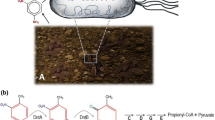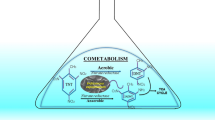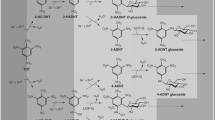Abstract
2,4,6-Trinitrotoluene (TNT) is released into natural environment from demilitarization facilities, manufacturing, and explosive remnants of war; this compound is one of the most recalcitrant explosives. TNT contamination is associated with human health risks because TNT strongly causes mutagenicity and carcinogenicity. Unfortunately, effective and affordable technologies to remediate TNT-contaminated environments are insufficient. As such, studies have been conducted to develop strategies using plants to extract and detoxify TNT from environment. In this study, a system was designed to overcome high phytotoxicity of TNT by expressing a NAD(P)H-flavin nitroreductase from Enterobacter cloacae to investigate the possibility of TNT phytoremediation. The resulting transgenic Arabidopsis showed a remarkable improvement in the ability to tolerate, absorb, and detoxify TNT as evidenced by their growth condition. This study can be used as reference to facilitate the effective cleanup of TNT-contaminated sites.








Similar content being viewed by others
References
Ayoub K, Hullebusch ED, Cassir M, Bermond A (2010) Application of advanced oxidation processes for TNT removal: a review. Hazard Mater 178:10–28
Baker NR, Rosenqvist E (2004) Applications of chlorophyII fluorescence can improve crop production strategies: an examination of future possibilities. J Exp Bot 403:1607–1621
Bernstein A, Ronen Z (2012) Biodegradation of the explosives TNT, RDX and HMX. In: Singh SN (ed) Microbial degradation of xenobiotics. Environmental science and engineering, Spring-Verlag, Berlin, Heidelberg, pp 135–176. doi:10.1007/978-3-642-23789-8_5
Bryant C, Hubbard L, McElroy WD (1991) Cloning, nucleotide sequence, and expression of the nitroreductase gene from Enterobacter cloacae. J Biol Chem 266:4126–4130
Eapen S, Singh S, D’Souza SF (2007) Advances in development of transgenic plants for remediation of xenobiotic pollutants. Biotechnol Adv 25:442–451
Ekman DR, Lorenz WW, Przybyla AE, Wolfe NL, Dean JFD (2003) SAGE analysis of transcriptome responses in Arabidopsis roots exposed to 2,4,6-trinitrotoluene. Plant Physiol 133:1397–1406
Esteve-Núñez A, Caballero A, Ramos JL (2001) Biological degradation of 2,4,6-trinitrotoluene. Microbiol Mol Biol Rev 65:335–352
Hannink N, Rosser SJ, French CE, Basran A, Murray JA, Nicklin S, Bruce NC (2001) Phytodetoxification of TNT by transgenic plants expressing a bacterial nitroreductase. Nat Biotechnol 19:1168–1172
Hawari J, Beaudet S, Halasz A, Thiboutot S, Ampleman G (2000) Microbial degradation of explosives: biotransformation versus mineralization. Appl Microbiol Biotechnol 54:605–618
Khan MI, Lee J, Park J (2013) A toxicological review on potential microbial degradation intermediates of 2,4,6-trinitrotoluene, and its implications in bioremediation KSCE. J Civil Eng 17(6):1223–1231
Kobori T, Sasaki H, Lee WC, Zenno S, Saigo K, Murphy MEP, Tanokura M (2001) Structure and site-directed mutagenesis of a flavoprotein from Escherichia coli that reduces nitrocompounds. J Biol Chem 276:2816–2823
Mentewab A, Cardoza V, Stewart CN (2005) Genomic analysis of the response of Arabidopsis thaliana to trinitrotoluene as revealed by cDNA microarrays. Plant Sci 168:1409–1424
Moon HM, Subramanian M, Rollo S, Oliver D, Shanks JV (2004) Use of Arabidopsis as a model system for genetic and biochemical studies of TNT transformation in plants. In: Sustainable range management conference, New Orleans
Murashige T, Skoog F (1962) A revised medium for rapid growth and bioassays with tobacco tissue cultures. Physiol Plant 15:473–497
Nepovím A, Hubálek M, Podlipná (2004) In vitro Degradation of 2,4,6 Trinitrotoluene using plant tissue cultures of solanum aviculare and rheum palmatum. Eng Life Sci 4(1):46–49
Nipper M, Carr RS, Biedenbach JM, Hooten RL, Miller K, Saepoff S (2001) Development of marine toxicity data for ordnance compounds. Arch Environ Contam Toxicol 41:308–318
Nyanhongo GS, Schroeder M, Steiner W, Gubitz GM (2005) Biodegradation of 2,4,6-trinitrotoluene (TNT): an enzymatic perspective Biocatal. Biotransform 23(2):53–69
Panz K, Miksch K (2012) Phytoremediation of explosives (TNT, RDX, HMX) by wild-type and transgenic plants. J Environ Manag 113:85–92
Panz K, Miksch K (2014) Phytoremediation of soil contaminated with explosive compounds. Environ Sci Eng. doi:10.1007/978-319-01083-0_11
Peng RH, Huang XM, Li X, Sun AJ, Yao QH, Peng YL (2001) Construction of a plant binary expression vector containing intron-kanamycin gene and transformation in Nicotiana tabacum. Acta Photophysiol Sin 27:55–60
Peng RH, Xiong AS, Yao QH (2006) A direct and efficient PAGE-mediated overlap extension PCR method for gene multiple-site mutagenesis. Appl Microbiol Biotechnol 73:234–240
Pennington JC, Brannon JM (2002) Environmental fate of explosives. Thermochim Acta 384:163–172
Ramos JL, Caballero A, Duque E, van Dillewijn P, González-Pérez MM, Esteve-Núñez A (2004) Physiological evidence for respiration of TNT by Pseudomonas sp. JLR11. In: Ramos JL (ed) Pseudomonas. Kluwer Academic/Plenum, London, pp 229–240
Robidoux PY, Hawari J, Bardai G, Paquet L, Ampleman G, Thiboutot S, Sunahara GI (2002) TNT, RDX, and HMX decrease earthworm (Eisenia andrei) life-cycle responses in a spiked natural forest soil. Arch Environ Contam Toxicol 43:379–388
Rosser SJ, French CE, Bruce NC (2001) Special symposium: engineering plants for the phytodetoxification of explosives. In vitro Cell Dev Biol Plant 37:330–333
Rylott EL, Lorenz A, Bruce NC (2010) Biodegradation and biotransformation of explosives. Curr Opin Biotechnol 22(3):1–7
Spain JC (2000) Introduction. In: Spain JC, Hughes JB, Knackmuss HJ (eds) Biodegradation of nitroaromatic compounds and explosives. Lewis, Boca Raton, pp 1–5
Symons ZC, Bruce NC (2006) Bacterial pathways for degradation of nitroaromatics. Nat Prod Rep 23(6):845–850
Van Aken B (2009) Transgenic plants for enhanced phytoremediation of toxic explosives. Curr Opin Biotechnol 20:231–236
Van Aken B, Yoon JM, Just CL, Schnoor JL (2004) Metabolism and mineralization of hexahydro-1,3,5-trinitro-1,3,5-triazine inside poplar tissues (Populus deltoides x nigra DN-34). Environ Sci Technol 38:4572–4579
Vanek T, Nepovim A, Podlipna R, Huebner A, Vavrikova Z, Gerth A, Thomas H, Smrcek S (2006) Phytoremediation of explosives in toxic wastes. In: Twardowska I et al (eds) Soil and water pollution monitoring, protection and remediation. Springer, Netherlands, pp 3–23
Vanek T, Gerth A, Vavrikova Z, Podlipna R, Soudek P (2007) Phytoremediation of explosives. In: Marmiroli N, Samotokin B, Marmiroli M (eds) Advanced science and technology for biological decontamination of sites affected by chemical and radiological nuclear agents, vol 75. NATO Science series, Series IV: Earth and environmental sciences, Springer, Dordrecht, pp 209–225
Varun M, D’Souza R, Kumar D, Paul MS (2011) Bioassay as monitoring system for lead phytoremediation through Crinum asiaticum L. Environ Monit Assess 178:373–381. doi:10.1007/s10661-010-1696-9
Vila M, Lorber-Pascal S, Laurent F (2007) Fate of RDX and TNT in agronomic plants. Environ Pollut 148:148–154
Vila M, Lorber-Pascal S, Laurent F (2008) Phytotoxicity to and uptake of TNT by rice. Environ Geochem Health 30:199–203
Williams RE, Rathbone DA, Scrutton NS, Bruce NC (2004) Biotransformation of explosives by the old yellow enzyme family of flavoproteins. Appl Environ Microbiol 70(6):3566–3574
Xiong AS, Yao QH, Peng RH, Duan H, Li X, Fan HQ, Cheng ZM, Li Y (2006) PCR-based accurate synthesis of long DNA sequences. Nat Protoc 1:791–797
Zaripov SA, Naumov AV, Abdrakhmanova JF, Garusov AV, Naumova RP (2002) Models of 2,4,6-trinitrotoluene (TNT) initial conversion by yeasts. FEMS Microbiol Lett 217(2):213–217
Zhang X, Henriques R, Lin SS, Niu QW, Chua NH (2006) Agrobacterium-mediated transformation of Arabidopsis thaliana using the floral dip method. Nat Protoc 1:641–646
Zhu B, Peng RH, Fu XY, Jin XF, Zhao W, Xu j, Han HJ, Gao JJ, Xu ZS, Bian L, Yao QH (2012) Enhanced transformation of TNT by Arabidopsis plants expressing an old yellow enzyme. Plos One 7(7):e39861
Ziganshin AM, Naumova RP, Pannier AJ, Gerlach R (2010) Influence of pH on 2,4,6-trinitrotoluene degradation by Yarrowia lipolytica. Chemosphere 79(4):426–433
Acknowledgments
The research was supported by the Key Project Fund of the Shanghai Municipal Committee of Agriculture (zhongzi2013-8, zhongzi2014-2, jizhi2014 1-3), International Scientific and Technological Cooperation (13440701700), Agriculture science technology achievement transformation fund (133919N1300, 143919N0300), National Natural Science Foundation (31071486, 31200212, 31200075, 31200076). Basic research in the field of science and technology project of Science and Technology Commission of Shanghai Municipality (14JC1403602).
Author information
Authors and Affiliations
Corresponding authors
Additional information
S.-H. You and B. Zhu contributed equally to this article.
Rights and permissions
About this article
Cite this article
You, SH., Zhu, B., Han, HJ. et al. Phytoremediation of 2,4,6-trinitrotoluene by Arabidopsis plants expressing a NAD(P)H-flavin nitroreductase from Enterobacter cloacae . Plant Biotechnol Rep 9, 417–430 (2015). https://doi.org/10.1007/s11816-015-0379-y
Received:
Accepted:
Published:
Issue Date:
DOI: https://doi.org/10.1007/s11816-015-0379-y




